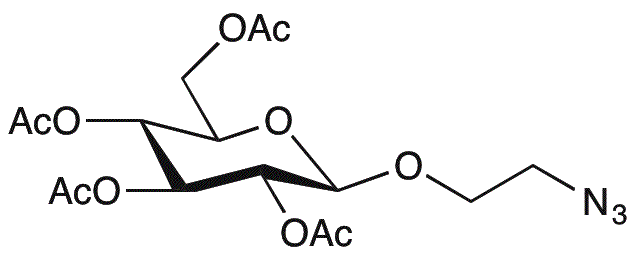2-Azidoethyl 2,3,4,6-tetra-O-acetyl-b-D-glucopyranoside is widely utilized in research focused on:
- Glycobiology: This compound serves as a versatile building block for synthesizing glycoproteins and glycolipids, essential for studying cell-cell interactions and signaling pathways.
- Drug Development: It is used in the design of carbohydrate-based drugs, enhancing the efficacy and targeting of therapeutic agents in treating diseases such as cancer.
- Bioconjugation: The azido group allows for click chemistry applications, facilitating the attachment of biomolecules to surfaces or other compounds, which is crucial in creating targeted drug delivery systems.
- Diagnostics: This chemical can be employed in the development of diagnostic tools, such as biosensors, that utilize carbohydrate recognition elements for detecting specific biomolecules.
- Material Science: It finds applications in creating functionalized polymers and materials, which can be tailored for specific properties in biomedical engineering and nanotechnology.
General Information
Properties
Safety and Regulations
Applications
2-Azidoethyl 2,3,4,6-tetra-O-acetyl-b-D-glucopyranoside is widely utilized in research focused on:
- Glycobiology: This compound serves as a versatile building block for synthesizing glycoproteins and glycolipids, essential for studying cell-cell interactions and signaling pathways.
- Drug Development: It is used in the design of carbohydrate-based drugs, enhancing the efficacy and targeting of therapeutic agents in treating diseases such as cancer.
- Bioconjugation: The azido group allows for click chemistry applications, facilitating the attachment of biomolecules to surfaces or other compounds, which is crucial in creating targeted drug delivery systems.
- Diagnostics: This chemical can be employed in the development of diagnostic tools, such as biosensors, that utilize carbohydrate recognition elements for detecting specific biomolecules.
- Material Science: It finds applications in creating functionalized polymers and materials, which can be tailored for specific properties in biomedical engineering and nanotechnology.
Documents
Safety Data Sheets (SDS)
The SDS provides comprehensive safety information on handling, storage, and disposal of the product.
Product Specification (PS)
The PS provides a comprehensive breakdown of the product’s properties, including chemical composition, physical state, purity, and storage requirements. It also details acceptable quality ranges and the product's intended applications.
Certificates of Analysis (COA)
Search for Certificates of Analysis (COA) by entering the products Lot Number. Lot and Batch Numbers can be found on a product’s label following the words ‘Lot’ or ‘Batch’.
Numéro de catalogue
Numéro de lot/série
Certificates Of Origin (COO)
This COO confirms the country where the product was manufactured, and also details the materials and components used in it and whether it is derived from natural, synthetic, or other specific sources. This certificate may be required for customs, trade, and regulatory compliance.
Numéro de catalogue
Numéro de lot/série
Safety Data Sheets (SDS)
The SDS provides comprehensive safety information on handling, storage, and disposal of the product.
DownloadProduct Specification (PS)
The PS provides a comprehensive breakdown of the product’s properties, including chemical composition, physical state, purity, and storage requirements. It also details acceptable quality ranges and the product's intended applications.
DownloadCertificates of Analysis (COA)
Search for Certificates of Analysis (COA) by entering the products Lot Number. Lot and Batch Numbers can be found on a product’s label following the words ‘Lot’ or ‘Batch’.
Numéro de catalogue
Numéro de lot/série
Certificates Of Origin (COO)
This COO confirms the country where the product was manufactured, and also details the materials and components used in it and whether it is derived from natural, synthetic, or other specific sources. This certificate may be required for customs, trade, and regulatory compliance.

